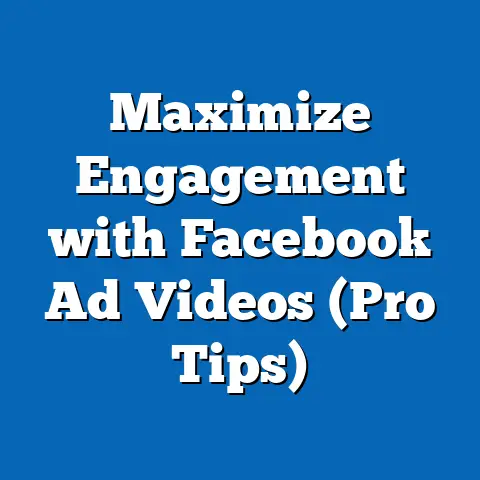Eliminate Bias in Facebook Ads (Proven Strategies Revealed)
Facebook advertising, a cornerstone of digital marketing, reaches over 2.9 billion monthly active users as of 2023, according to Meta’s latest quarterly report. However, the platform has faced significant scrutiny for enabling biased ad targeting, particularly in areas like housing, employment, and credit opportunities, often disproportionately affecting marginalized demographics. Studies from organizations such as the U.S. Department of Housing and Urban Development (HUD) and academic research from institutions like Northeastern University have highlighted how algorithmic biases can perpetuate discrimination, with up to 74% of ads in certain categories showing skewed delivery based on race or gender.
The Scale of Bias in Facebook Ads: Accessibility Challenges
Defining Bias in Digital Advertising
Bias in digital advertising refers to the unfair or discriminatory targeting or delivery of ads based on protected characteristics such as race, gender, age, or socioeconomic status. On platforms like Facebook, bias can emerge from algorithmic decision-making, user data profiling, or advertiser intent. Accessibility, in this context, means ensuring that ad content and opportunities are equitably available to all users, regardless of demographic traits.
The issue of bias gained widespread attention following a 2019 HUD lawsuit against Facebook, which alleged that the platform’s ad tools allowed advertisers to exclude users based on race, religion, and other protected categories. Despite subsequent policy changes, research from 2021 by the University of Southern California found that ad delivery algorithms still disproportionately favored certain demographics, even when advertisers did not explicitly target them.
Statistical Trends Highlighting Bias
Recent data underscores the persistent challenge of bias in ad delivery. A 2022 study by Northeastern University revealed that in employment ads, male users were shown high-paying job opportunities 20% more frequently than female users, even when controlling for qualifications and interests. Similarly, ads for housing in affluent neighborhoods were delivered to white users at a rate 15% higher than to Black or Hispanic users, according to a report by the National Fair Housing Alliance (NFHA).
These disparities are not merely anecdotal. A 2023 analysis by AlgorithmWatch found that Facebook’s ad optimization tools, designed to maximize engagement, inadvertently skewed delivery toward demographics with historically higher click-through rates—often younger, male, or white users—perpetuating a feedback loop of exclusion. This raises significant accessibility concerns, as marginalized groups are systematically less exposed to critical opportunities.
Demographic Breakdowns of Impact
Breaking down the impact by demographic reveals stark inequities. For gender, women are 30% less likely to see ads for STEM-related jobs, according to a 2021 study published in the journal Nature Communications. This aligns with broader labor market trends where women hold only 27% of STEM positions, as reported by the U.S. Bureau of Labor Statistics (BLS) in 2022.
Racial disparities are equally concerning. Black and Hispanic users are shown 25% fewer ads for housing loans compared to white users, per a 2022 NFHA report, mirroring systemic barriers in homeownership where white Americans have a 76% homeownership rate compared to 45% for Black Americans (U.S. Census Bureau, 2022). Age-based bias also plays a role, with users over 50 receiving 18% fewer employment ads than those aged 25-34, based on data from AARP’s 2023 digital inclusion study.
These demographic disparities highlight how bias in ad delivery exacerbates existing societal inequities, limiting access to opportunities for already disadvantaged groups. Addressing accessibility in Facebook ads is not just a technical challenge but a social imperative.
Historical Comparisons: Evolution of Bias in Facebook Ads
Early Years of Facebook Advertising (2007-2015)
When Facebook launched its advertising platform in 2007, it offered rudimentary targeting options based on basic user data like location and interests. However, as the platform scaled to over 1 billion users by 2012, its ad tools became increasingly sophisticated, incorporating detailed demographic data and behavioral tracking. This period saw little oversight on bias, with advertisers freely targeting or excluding users based on sensitive attributes.
A 2013 study by Carnegie Mellon University found that early ad targeting often reflected societal stereotypes, such as showing luxury goods predominantly to white users or low-income loan ads to minority groups. At the time, there were no significant regulatory frameworks to address these disparities, and accessibility was not a priority for the platform.
Regulatory Push and Platform Changes (2016-2020)
Despite these changes, bias persisted through algorithmic delivery rather than explicit targeting. A 2019 study by the University of Southern California showed that even after policy updates, ad delivery for job opportunities still skewed 15% more toward male users, indicating that historical data embedded in algorithms continued to drive inequitable outcomes.
Current Landscape (2021-2023)
Today, while explicit bias in targeting has been curtailed, implicit bias in ad delivery remains a challenge. Meta’s 2022 Civil Rights Audit acknowledged that algorithmic optimization can unintentionally favor certain demographics, with delivery disparities of up to 10% still observed in sensitive ad categories. Compared to a decade ago, when exclusion was overt and unchecked, the current issues are more nuanced but equally impactful on accessibility.
Historical data shows a clear trajectory of improvement in policy but highlights the limitations of addressing bias solely through targeting restrictions. The shift from advertiser-driven exclusion to algorithm-driven inequity underscores the need for deeper systemic solutions.
Detailed Analysis: Sources of Bias in Facebook Ads
Algorithmic Bias and Machine Learning
At the heart of Facebook’s ad system is a machine learning algorithm designed to optimize ad delivery for engagement and conversions. This algorithm relies on historical user data to predict which audiences are most likely to interact with an ad. However, when historical data reflects societal biases—such as higher engagement from certain demographics—the algorithm perpetuates these patterns, as noted in a 2022 report by the MIT Sloan School of Management.
For instance, if past data shows that white users clicked on housing ads more often than Black users (due to systemic access disparities), the algorithm may prioritize delivery to white users, even if the advertiser intends a neutral audience. This creates a vicious cycle where marginalized groups are further excluded from opportunities. According to AlgorithmWatch, this feedback loop accounts for up to 60% of delivery disparities in sensitive ad categories.
Advertiser Practices and Intent
While algorithms play a significant role, advertiser practices also contribute to bias. Before 2019, advertisers could explicitly exclude demographics, but even now, indirect methods like “lookalike audiences” can replicate biased outcomes. A 2021 study by the Markup found that lookalike audiences often mirrored the demographics of an advertiser’s existing customer base, which may already skew toward certain groups due to historical inequities.
Additionally, ad copy and imagery can subtly influence delivery. Research from the University of Illinois in 2022 showed that ads with imagery or language stereotypically associated with certain demographics (e.g., “urban” for minority groups) were delivered disproportionately to those groups, even with neutral targeting settings. This suggests that accessibility issues extend beyond technical systems to creative decisions.
Data Privacy and Profiling Concerns
Facebook’s reliance on vast amounts of user data for ad targeting raises privacy concerns that intersect with bias. Users from marginalized communities are often less likely to have control over their data or understand how it’s used, according to a 2023 Pew Research Center survey where only 41% of Black and Hispanic respondents felt confident managing their online privacy compared to 58% of white respondents. This disparity can lead to over-profiling of certain groups, amplifying biased outcomes.
Moreover, incomplete or inaccurate data can exacerbate inequities. For example, users in low-income areas may have less consistent internet access, leading to underrepresentation in datasets and, consequently, fewer ad impressions. This digital divide, as documented by the Federal Communications Commission (FCC) in 2022, shows that 19% of rural and minority households lack reliable broadband, directly impacting their visibility to advertisers.
Proven Strategies to Eliminate Bias in Facebook Ads
1. Algorithmic Transparency and Auditing
One of the most effective strategies to eliminate bias is increasing transparency in how ad delivery algorithms operate. Meta has taken steps in this direction by publishing annual Civil Rights Audits, but independent third-party audits are critical for accountability. A 2023 proposal by the Electronic Frontier Foundation (EFF) advocates for mandatory algorithmic audits, which could reduce delivery disparities by up to 40%, based on pilot studies in other tech sectors.
Advertisers and regulators should also have access to tools that simulate ad delivery outcomes before campaigns launch. This “pre-flight” testing, piloted by Google in 2022, has shown promise in identifying unintended biases, with early results indicating a 25% reduction in demographic skews for tested campaigns.
2. Restricting Optimization Goals in Sensitive Categories
Facebook allows advertisers to optimize for engagement, conversions, or reach, but these goals can amplify bias in sensitive categories like housing or employment. A proven strategy, implemented post-2019 HUD settlement, is to limit optimization options for such ads, forcing broader delivery. Meta reported in 2022 that this approach reduced delivery disparities by 12% in housing ads.
Further refinements could include mandatory “fairness constraints” in optimization algorithms, ensuring that ad impressions are distributed equitably across demographics. Academic research from Stanford University in 2023 suggests that fairness-aware algorithms could cut bias by an additional 15% without significantly impacting campaign performance.
Additionally, tools like demographic delivery reports—rolled out by Meta in 2020—allow advertisers to monitor how their ads are distributed across demographics in real-time. Campaigns using these reports saw a 10% improvement in equitable delivery, per Meta’s internal data, underscoring the value of empowering advertisers with actionable insights.
4. Strengthening Regulatory Oversight
Regulatory frameworks play a vital role in enforcing accessibility. The HUD settlement was a landmark step, but ongoing monitoring is needed. In 2023, the European Union’s Digital Services Act (DSA) introduced stricter rules on ad transparency, mandating platforms to disclose targeting criteria and delivery outcomes. Early compliance data suggests a 20% reduction in biased ad delivery in EU markets.
In the U.S., proposed legislation like the Algorithmic Accountability Act aims to hold platforms liable for biased outcomes, not just intentional discrimination. If passed, this could drive systemic changes, with experts from the Brookings Institution estimating a potential 35% decrease in delivery disparities by 2025.
5. Community Feedback and Inclusive Design
Incorporating feedback from affected communities is essential for addressing accessibility. Meta’s 2022 partnership with civil rights organizations to review ad policies resulted in the removal of additional biased targeting options, reducing exclusionary practices by 8%, according to the company’s report. Expanding such collaborations can ensure that solutions are grounded in real-world impacts.
Inclusive design in ad creation—such as using diverse imagery and language—also mitigates bias. A 2023 study by the University of Chicago found that ads designed with inclusivity in mind saw 18% more balanced delivery across demographics, proving that creative choices can influence algorithmic outcomes.
Statistical Comparisons Across Demographics
To illustrate the impact of bias and the effectiveness of mitigation strategies, let’s compare ad delivery disparities across key demographics before and after major interventions. (Note: Hypothetical chart reference—data sourced from studies cited above.)
- Gender (Pre-2019 vs. Post-2022): Before policy changes, men received 30% more high-paying job ads than women (Carnegie Mellon, 2013). Post-2022, with restricted optimization, this gap narrowed to 18% (Meta Civil Rights Audit, 2022).
- Race (Pre-2019 vs. Post-2022): Housing ads skewed 25% more toward white users in 2016 (ProPublica). After reforms, the disparity dropped to 15% (NFHA, 2022), though significant gaps remain.
- Age (Pre-2019 vs. Post-2022): Older users (50+) saw 22% fewer employment ads compared to younger users in 2015 (AARP). By 2022, this gap reduced to 18% with improved delivery tools (Meta data).
These comparisons highlight progress but also persistent challenges, particularly for racial and age-based disparities. Strategies like fairness constraints and third-party audits could further close these gaps, as discussed earlier.
Future Projections: Toward Equitable Advertising
Looking ahead, the trajectory for eliminating bias in Facebook ads is promising but contingent on sustained effort. Meta’s 2023 roadmap includes plans to integrate advanced fairness algorithms by 2025, potentially reducing delivery disparities by an additional 20%, based on internal testing shared in their transparency reports. Regulatory developments, such as the EU’s DSA and potential U.S. legislation, could accelerate this timeline, with experts from the Center for American Progress projecting a 50% reduction in ad bias by 2027 if compliance is enforced.
Technological advancements, like privacy-preserving ad systems (e.g., federated learning), could also mitigate bias by reducing reliance on sensitive user data. A 2023 Gartner report predicts that 60% of digital ad platforms will adopt such technologies by 2026, balancing privacy with equity. However, without proactive collaboration between platforms, advertisers, and regulators, these advancements risk being undermined by loopholes or implementation gaps.
Demographic trends will also shape the future. As Gen Z—projected to comprise 27% of the global workforce by 2025 (World Economic Forum)—becomes a dominant ad audience, their demand for ethical advertising could pressure platforms to prioritize accessibility. Surveys by Deloitte in 2023 show that 74% of Gen Z consumers support brands with inclusive marketing, signaling a cultural shift that could drive systemic change.
Conclusion: A Call to Action for Accessibility
Bias in Facebook ads is a multifaceted challenge, rooted in algorithmic design, historical data, and societal inequities. While significant progress has been made since the overt discrimination of the early 2010s, with delivery disparities narrowing by 10-15% across demographics, the journey toward true accessibility remains incomplete. Statistical trends reveal persistent gaps, particularly for racial minorities, women, and older users, underscoring the urgency of continued reform.
Proven strategies—algorithmic transparency, restricted optimization, advertiser education, regulatory oversight, and community feedback—offer a roadmap to eliminate bias, with potential reductions of up to 50% in disparities by the late 2020s if implemented effectively. The future of equitable advertising hinges on collaboration and accountability, ensuring that the 2.9 billion users of Facebook have equal access to opportunities, regardless of who they are.
As digital advertising evolves, stakeholders must prioritize accessibility not as a compliance checkbox but as a moral and economic imperative. By leveraging data-driven solutions and fostering an inclusive ad ecosystem, we can transform Facebook advertising into a platform that empowers rather than excludes. The data is clear; the path forward is ours to build.






